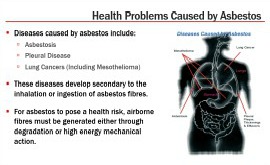What are the Health Effects of Asbestos
Asbestos fibres can remain unchanged in the body for years. However when changes progress the effects are serious.

Asbestos fibres can remain unchanged in the body for years. However when changes progress the effects are serious.

What is Asbestos?
|
||
Asbestos types are categorised as Amphiboles and Serpentine. Amphiboles include; Amosite (Brown) and Crocidolite (Blue), and also fibrous Actinolite, Anthophyllite, and Tremolite. Serpentine asbestos is Chrysotile (White). Chrysotile is the most abundant and most commonly used form, it is found in many manufactured products. Asbestos properties including; heat resistance, tensile strength, incombustibility and chemical resistance have led to its widespread use in over 2,500 applications, including many construction and refurbishment building materials. These materials that contain asbestos are known as asbestos containing materials (ACMs). The health effects as a result of exposure to asbestos are well known, inhalation of asbestos fibres can cause serious disease and including asbestosis and mesothelioma. CES is an IANZ accredited laboratory and has been accredited since 1996. Our approved analysis methods based on AS 4964 – 2004 Method for the qualitative identification of asbestos in bulk samples’ and UK guidance document ‘HSG 248: The Analysts Guide’. We are accredited for all six types of asbestos, Asbestos fibre counting and full quanitifcation of Asbestos in Soil to provide results that can be managed under the BRANZ Asbestos in Soil Guidelines. |
||